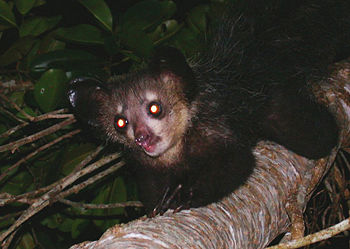Aye-aye
The Aye-aye is the sole living member of the family Daubentoniidae. Aye-ayes are a type of lemur. They are found only in Madagascar and are the largest nocturnal primate. Like many primates today, their survival is threatened by loss of habitat and human predation.
Physical Characteristics
The physical appearance of Aye-ayes is extremely unique. They are about the size of a cat and have large ears, grey-black fur, and long, bushy tails. Their digits are also elongated, especially the middle fingers. Aye-ayes have a reflective tapetum that helps them detect light at night and makes their eyes shine like a cat's do when you shine a flashlight at them.
The teeth of Aye-ayes grow continuously like a rodents -- a unique trait among primates. Their large, powerful incisors help them tear through wood to get to the grubs they like to eat so much.
Their appearance is so strange that the people of Madagascar are afraid of them and consider them to be a bad omen.
Habitat
Aye-ayes live in forests in Madagascar. They spend most of their time in trees, and build nests to sleep in during the day.
Diet
Aye-ayes take over the ecological niche that woodpeckers usually occupy in other areas of the world. They use their especially long middle fingers to forage for food by tapping them on things like wood. They then use their large ears to listen to the sound the wood makes in order to find hollow spots where larvae live. They will then use their long incisors to tear a hole in the wood and fish out the larvae with their middle finger. Aye-ayes eat mainly larvae, nuts, and fiberous fruits such as coconuts and mangoes.
Behavior
Aye-ayes are mainly solitary creatures. Tracking them in the wild requires following them through the forest during the night when they're active. As can be guessed, this is a difficult task and so some portions of the Aye-ayes life are still not well-known. For example, lifespan in the wild is not well known, but in captivity they usually live to be about 23 years old.
Reproduction
Sexual maturity for Aye-ayes occurs at about 2-3 years of age. They usually only have one infant and gestation ranges from 160-170 days or about 5-6 months. While hunting during the night, female Aye-ayes leave their infants "parked" in the nest.
Classification
Kingdom: Animalia
Phylum: Chordata
Class: Mammalia
Order: Primates
Suborder: Prosimii
Family: Daubentoniidae
Genus: Daubentonia
Species: madagascariensis
References
Corliss Pearl, Mary. The Illustrated Encyclopedia of Wildlife. "Prosimians: Lemurs, Bush Babies, Tarsiers, etc." Grey Castle Press (c) 1991.
Kite, Lorien. Nature's Children: Lemurs. Grolier Educational (c) 1999.
